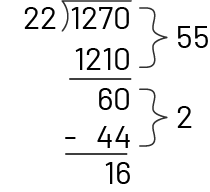B2.8 Represent and solve problems involving the division of three-digit whole numbers by decimal tenths, using appropriate tools, strategies, and algorithms, and expressing remainders as appropriate.
Activity 1: At the Butcher's!
Present the following problem to students.
A butcher received 127 kg of meat in the last delivery. He needs to prepare packages of meat weighing 2.2 kg each. How many packages of meat can he prepare?
Example
The student may decide to create an equivalent division with whole numbers by multiplying the decimal number by 10 (\(2.2\; \times \;10\; = \;22\)) to remove the decimal. To maintain equivalency, 127 must also be multiplied by 10.
T(\(127\; \times \;10\; = \;1\;270\)).
So, \(127\; \div \;2.2\; = \;1\;270\; \div \;22\).

The student then adds the partial quotients to find the answer: \(55\; + \;2\; = \;57\).
The butcher can then prepare 57 packages of 2.2 kg of meat.
Ask students questions such as:
- What algorithm did you use to solve the problem? What strategies? What concrete material? Justify your choice.
- In this situation, what are the relationships between multiplication and division?
- How can we represent the remainder? How do you know?
- How much meat is left? If the butcher decides to distribute the remaining meat equally among the 57 packages, how much more should go in each package?
- How can we check the plausibility of the answer?
Activity 2: The World Record
Present the following problem to students:
In 2022, Hidekichi Miyazaki held the world record in the 100 m race for those over 105 years old. In 2015, he ran the 100 m distance in 42.2 seconds. On average, how many seconds did he manage to run 1 m?
Allow students to use the strategy or algorithm of their choice.
Ask questions such as:
- In this situation, what is the divisor? The dividend? How do you know?
- What strategy can be used to solve the problem? Which algorithm? What concrete material can be used? Justify your choice.
- Is there a remainder? If so, how can we represent it? Explain your reasoning.
- How can we be sure that the calculation is plausible?
